A Double Take, Part 2
Last week, I started telling some card-by-card design stories about cards reprinted in Double Masters 2022, but there were a lot of stories to tell, so I'm continuing today.
Body Double
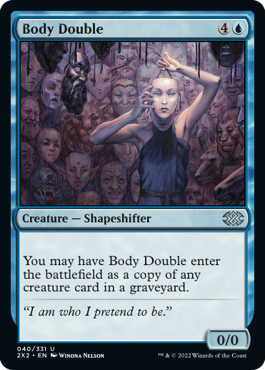
One of the quirks of Magic design is that you can use components of a color to design cards that aren't of that color. The designers find this funny, so we often will design cards like this as a joke for one another.
Death Clone
4U
Creature — Clone
As ~ comes into play, you may choose a creature card in a graveyard. If you do, ~ comes into play as a copy of that creature card.
Other than the creature type changing (Clones were creature type Clone early in the game), the card was pretty much "brain to print" as we call it in R&D. Here's the art description for the original card:
Art Description
Color: Blue
Location: Your choice
Action: This shapeshifting creature takes the form of another creature, but only if that creature is now gone. Show a leafy, verdant treefolk of your design, and show the long-dead, dried-out, fallen treefolk at its feet almost like a shadow. Feel free to add some slight indication that the living treefolk is a shapeshifter.
Focus: The living copy of the dead treefolk
Mood: A cold duplicate.
Notes: Do your best to design a cool-looking treefolk. We don't want just a tree with a face on it.
And here's the art description for the art they used on the Double Masters 2022 version of the card:
Art Description
NO SPECIFIC SETTING OR STYLEGUIDE
Color: Blue Creature
Location: A sparse sculptor's workshop.
Action: A human-looking female (shapeshifter) stands in front of a stone wall where dozens of realistic masks hang in ordered rows. The masks can resemble human and humanoid creatures (give us a good mix please). The female figure has her head bowed slightly as she places a mask upon her face. The room is lit by moonlight perhaps coming in from a skylight.
Focus: The female shapeshifter
Mood: I am who I pretend to be.
Looking back, I regret making
Figure of Destiny
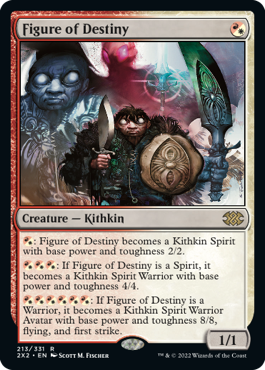
This card is the brainchild of Brian Tinsman. We were working on the design of Eventide, and Brian turned in the following card:
Evolving Warrior
(r/w)(r/w)
Enchantment
(r/w): CARDNAME is a 2/2 Warrior until end of turn.
(r/w)(r/w)(r/w): If CARDNAME is a Warrior, it gains creature type Spirit, gets +2/+2, and gains first strike until end of turn.
(r/w)(r/w)(r/w)(r/w)(r/w): If CARDNAME is a Spirit, it gains creature type Avatar, gets +4/+4 and gains flying until end of turn.
I had a chance to ask Brian what his inspiration for
"I was looking for a card that tells a story, and even better, lets the player participate in the story. This character is a hero, but only because you helped him along the journey! I was also enjoying the idea of using multiple additive creature types as anchors for abilities. I don't think that had been done before. I was concerned its heavy text might be too cumbersome, but playtesters got the concept right away and it became a favorite with the team."
The card was quirky but instantly lovable. At the time, Magic had had creatures that upgraded once, with something like threshold, but never multiple times (other than just gaining +1/+1 counters, I guess). Brian wanted a creature that changed three different times. The basic mechanics were there from the beginning. As Brian referenced, the card gains creature types, allowing it to be affected by the next activation.
Brian turned the card in as an enchantment, but I quickly changed it to a creature, which allowed us to go from 1/1 to 2/2 to 4/4 to 8/8, doubling in size each time. The creature, as printed, ended up as an 8/8 Spirit Warrior Avatar with first strike and flying, but the activation costs, the template, and when the abilities are gained changed throughout design. It's another example of a card that was close in its first incarnation to what it would become.
The more interesting story about this card had to do with a fight over something that didn't even end up on the card. Brian made the choice to create permanent changes that weren't indicated anywhere on the card. Usually when we permanently change the size of a creature, we use +1/+1 counters. The rules manager at the time, Mark Gottlieb, felt strongly that we should template the card using counters, because that was how Magic templating did this. (I do want to stress that it's the rules manager's job to try and get cards templated the way we template every other card that's similar, so Mark was doing what he was supposed to be doing.) Brian, though, really didn't want to use +1/+1 counters. In the end, I think Brian won out, but only because the rules text didn't fit if it used the +1/+1 counter rules text.
The popularity of
Here's the art description for the original card:
Art Description
Color: Red and white creature
Location: None
Action: This is an abstract piece that depicts a kithkin whose spirit will go on to do great things once he dies. Show an ordinary male kithkin. Looming just above and behind him is his ghostly self, arms spread slightly. Just beyond that is his warrior-spirit self, stronger and more noble, and less "human"—less distinct facial features—wielding a sword. Beyond the warrior-spirit self is the avatar self, a majestic spirit that is grander and more ethereal/abstract than all the rest, wielding a grand ghost-sword.
Focus: The creature starts as an ordinary kithkin, so that should be the most distinct.
Mood: Evolving into ghostly greatness
Notes: Four silhouettes, one in front of the other, ranging in "grandiosity" from a simple kithkin to a great ghost-avatar.
Necrotic Ooze
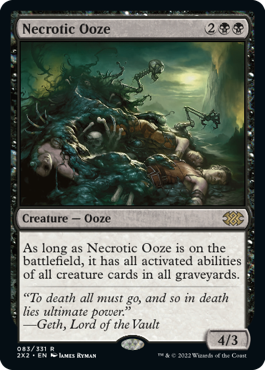
The Simic had a "+1/+1 counters matter" theme, so we thought it would be cool that it got the keyword abilities of any creature you controlled with a +1/+1 counter on it. It turns out that outside of acorn cards, you can't just say "keyword abilities"; you have to actually spell them out, which is why the first version of the card looked like this:
Experiment #247C
2GGUU
Legendary Creature — Mutant Ooze
4/6
T: Put a +1/+1 counter on target creature. As long as another creature with a +1/+1 counter on it has flying, CARDNAME has flying. The same is true for fear, first strike, double strike, landwalk, protection, trample, and vigilance. CARDNAME has all activated abilities of creatures with +1/+1 counters on them. (If any of the abilities use those creatures' names, use this creature's name instead.)
First off, yes, those were the evergreen abilities when Dissension came out. This version ended up being a bit wordy, so we switched it from copying keyword mechanics to copying activated abilities as that required fewer words. We do occasionally make cards with the above template, but I think there were enough activated abilities on Simic cards that we felt comfortable with copying activated abilities.
Anyway,
For example, if we never copied
Cut to Scars of Mirrodin design. The set has a graveyard theme, so it occurs to me that it might be fun to take
Zombie Kraj
1BB
Creature — Ooze
2/2
CARDNAME has the activated abilities of all permanent cards in your graveyard.
You can tell from the name that I wasn't hiding the card's inspiration. I made it an Ooze because I love Oozes and flavorfully it felt like it could be an Ooze. Yes, the name and the creature type don't match, but the name wasn't evocative of what the new creature was supposed to be. In development, Aaron changed it from a 1BB 2/2 to a 2BB 4/3, but other than that he left it alone. Here's the art description for the original card:
Art Description
Color: Black creature
Location: The Mephidross
Action: Show a semitransparent, black, viscid, living ooze inching over a field of corpses. The ooze takes on attributes of the bodies it is passing over. The ooze has replicated various body parts—a jaw, a curved blade, a distorted hand, etc. We can see some half-metal bones jutting through it.
Focus: The ooze.
Mood: A gruesome mimicry of the dead.
The Lieges
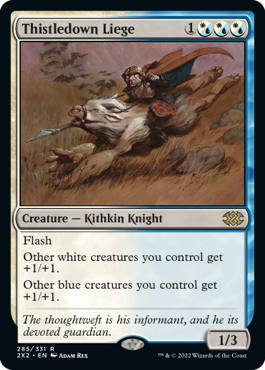
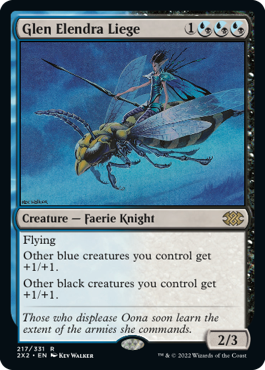
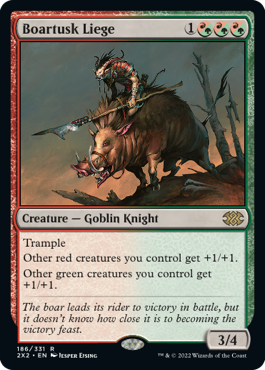
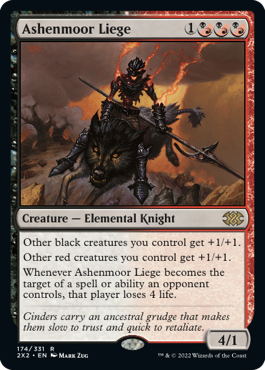
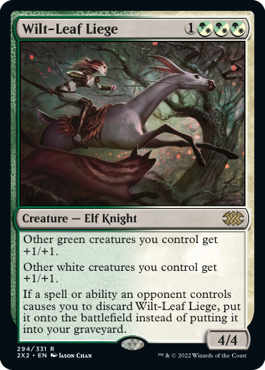
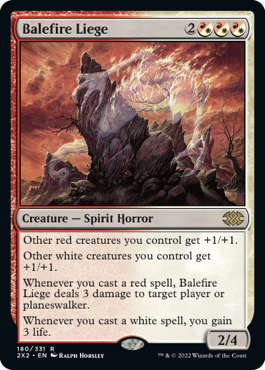
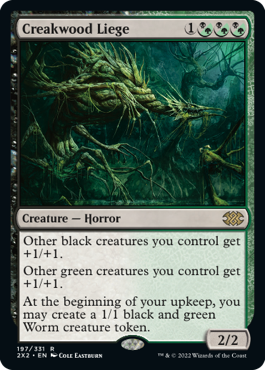
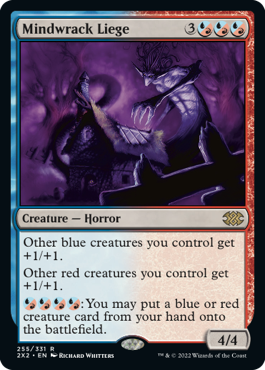
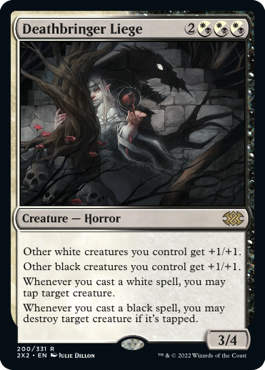
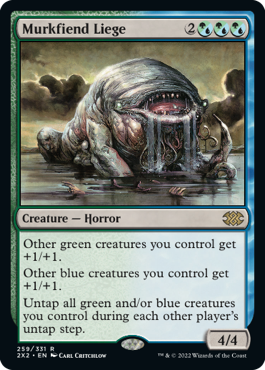
For these ten card designs, our story starts with the design of original Ravnica. I was experimenting with how to innovate with multicolor design and stumbled upon the idea of hybrid mana. Traditional multicolor cards treated the colors as an "and," but I was intrigued by the idea of it being an "or." What if you only needed one of the two colors to play the card?
This allowed the card to be equally accessible in a monocolor deck of either color or a two-color deck of both colors but acted similarly to a monocolor card in a multicolor deck of only one of the colors. I fell in love with the concept, but the rest of R&D wasn't quite as enamored with it as I was. I saw it as this amazing design tool, but it was originally seen more as a gimmick. I handed off the design with hybrid in it, but the development team (this predates our vision design, set design, and play design model) decided to take it out.
Ravnica had a lot going on in it, so I understood why it was removed. A big part of Magic design is deciding if things don't fit and finding another place for them in a later design.
My next plan was to include hybrid mana in Time Spiral. (You can see my excitement for hybrid mana as I found a place to use them so quickly.) Time was breaking down, so I thought we could use hybrid as a sign that the very nature of magic was unraveling.
We were a few months into Time Spiral's design when Brian Schneider, the lead developer for Ravnica, came to talk to me. They felt the set was a little low on splash and wanted to know if they could have hybrid mana back. It wasn't crucial to how Time Spiral was coming together, so I said sure. Interestingly, during those few months of having hybrid in Time Spiral, I started thinking about what would happen if the volume was a little higher than we'd originally planned in Ravnica. It just got me thinking that it would be cool one day to have a set with a high concentration of hybrid mana.
Flash forward about a year, and R&D had been asked if we wanted to do a "fourth set" for the Ravnica year. We said we didn't, so we didn't plan anything. Then one day, we heard from the brand team that they decided they wanted a set in that late summer slot, and we had to quickly put one together. That ended up being Coldsnap.
It was designed very quickly. I believe we had a month on it, which, for Magic design, is insanely fast. It did have a full, normal development cycle. After we finished Coldsnap, I told Bill Rose (the VP of R&D at the time, now the VP of tabletop Magic) that the next time we want to have a four-set Magic "year," let me know and I'd make something more cohesive, where it all felt like a singular thing, something we planned, rather than thrown together. Right before Lorwyn was set to start design, Bill came to me and said, "Okay. I need a four-set year."
My idea was two mini two-set blocks where each set had its own mechanical identity, but they were synergistic with one another. I worked with the creative team to come up with a plane that went through a major metamorphosis. Lorwyn had already been tagged as a creature type–focused set, so the challenge was to find a mechanical theme for Shadowmoor. I needed it to care about something that Lorwyn would naturally contain, just as the specific creature types were something that Shadowmoor could easily include. It was then that I realized that quality could be color. A "colors matter" set would be something unique to Shadowmoor but relevant to Lorwyn. And I had the perfect tool for a colors-matter set—hybrid mana. It allowed you to play cards of another color in your deck without requiring the mana. Perfect.
I approached Shadowmoor with the idea that I wanted as high of an as-fan for hybrid mana as the set could hold. At the time, I concluded that was seven (i.e., half the booster pack, minus the basic land). With 20/20 hindsight, that a was a little too high, but I get that I was trying to push boundaries.
Anyway, once we had a hybrid-focused set, we were looking for cycles to hammer home what cool things hybrid could do. The earliest version of the Lieges generated effects based on using certain colors of creatures. Each color granted a different ability, allowing you to grant both abilities to creatures of both colors. Here's the earliest version of
Kithkin Coordinator (version #1)
3(w/u)
Creatrure — Kithkin Wizard
1/4
Whenever a white creature you control is tapped, gain 1 life.
Whenever a blue creature you control is the target of a spell or ability, tap or untap target creature.
As you can see, the mana cost just required a single hybrid mana and generated spell-like effects rather than enhancing the creatures. The impetus behind this cycle was playing more into the "colors matter" space, as cards could be colors that their controllers didn't have mana available for, allowing interesting combinations.
Kithkin Coordinator (version #2)
3(w/u)
Creatrure — Kithkin Wizard
1/4
Whenever a white creature you control becomes untapped, it gets +1/+1 until end of turn.
Whenever a blue creature you control becomes tapped, it gains shroud until end of turn.
The next version shifted more toward granting the creatures abilities. I think this was the version handed off in design.
Shadowmoor development, led by Aaron Forsythe, decided to make these much simpler. Inspired by
All the Shadowmoor creatures were costed at 1HHH (H is the symbol we use to represent "unspecified hybrid mana"), but their power and toughness varied based on how aggressive the color got to be on creatures and on what their noncreature-boosting ability was. They were all flavored as Knights and reflected whatever creature type was core to that two-color combination (white-blue—Kithkin; blue-black—Faerie; black-red—Elemental; red-green—Goblin; and green-white—Elf).
The reason their mana cost had so much hybrid mana in it was because we were trying to be careful of how easy they were to splash in decks playing other colors. There was a lot of experimentation in the set about seeing how many mana symbols we could include. Eventide would have the chroma mechanic, the precursor to devotion, so having a lot of mana symbols would be mechanically relevant in Standard.
When we made Eventide, we decided to make the set about the enemy colors to allow us to make more hybrid cards (as we'd taxed out most of the design space for allied hybrid). We talked about whether we needed to make the enemy cycle of the Lieges but decided players would be upset if we didn't.
We quickly ran into several issues. One, we found it problematic to make five more cards at exactly 1HHH that didn't feel too close to the first five, so we ended up allowing them to be anywhere from 1HHH to 3HHH. Two, there weren't creature types as neatly lined up for the enemy color combinations as there had been for the ally ones, so the solution was to make them all Horrors. This also let them look a bit different than the ally versions, as they weren't Knights riding something. We allowed ourselves to make the extra ability a bit more complex on the enemy versions. The one mechanical thing tying them together is that they cared about the two colors in some way. Two of them cared about when you cast certain colors of spells (white-black and red-white), two affected things of the particular colors (blue-red and green-blue), and one made creature tokens of both colors (black-green).
I believe the Lieges are the only full ten-card cycle to be included in Double Masters 2022.
Double Vision
I've hit my word count for today. I hope you enjoyed hearing the design stories behind some of Double Masters 2022's cards. As always, I'm eager to hear your feedback, whether it's on the article, any of the cards I talked about, or on Double Masters 2022 itself. You can email me or contact me through any of my social media accounts (Twitter, Tumblr, Instagram, and TikTok).
Join me next week for some life lessons I've learned over the years.
Until then, may these cards be as much fun to play as they were to make.
- Episode 942 Making New Magic Mechanics
- Episode 941 CLB Commander Decks with Gavin Verhey
- Episode 940 Creative Components

